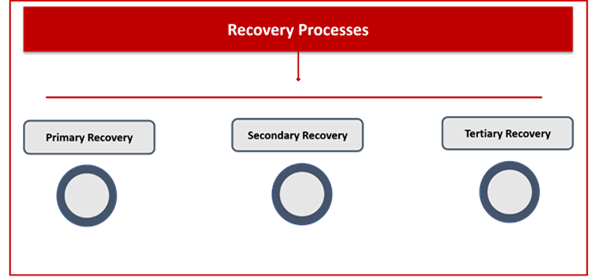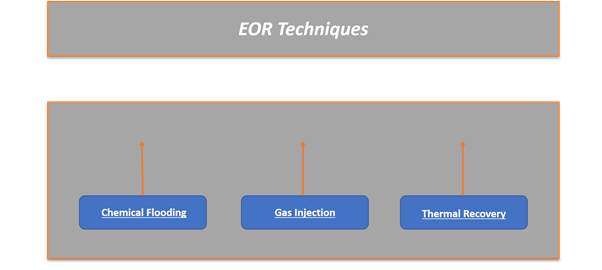The secondary recovery techniques come into play when the primary techniques fail to extract the deposited hydrocarbons from a reservoir in the oil and gas industry. The secondary recovery process involves the application of additional energy into the reservoir to pump the remaining hydrocarbons to the surface. The overall scenario to choose a secondary recovery technique plays around balancing the economics between the crude oil prices and the investment that will incur into the extraction of oil through a secondary recovery process.
Usually, the oil and gas flow up to the earth's surface on its own due to the high reservoir pressure conditions but sometimes, due to complex geological conditions or after making a significant primary recovery, the reservoir pressure declines and stops oil flowing. At this point in time, additional energy is required to stimulate the oil's flow.
The secondary recovery techniques require an additional sum of money; hence, oil companies first take an economic analysis before pouring money into secondary recovery.
Why do we require secondary recovery?
The secondary recovery techniques come into existence when the pressure inside the well drops to a level that makes primary recovery impossible. Reservoir pressure is the key driver of crude oil from underground rocks to the surface. When a well encounters the reservoir, the formation pressure pushed the oil from pores to flow to the surface. An external medium is required, reinforcing the reservoir pressure and recommending the oil's flow. The technique helps to enhance the recovery from a well.
What are different types of Recoveries?
There are three main types of recovery techniques used in the industry. Let us try to understand them and comprehend why there is a need for multiple types of recovery techniques.

Copyright © 2021 Kalkine Media Pty Ltd
- Primary Recovery: Primary recovery is the first and most fundamental recovery process. Oil deposited in an underground reservoir is found in mixed form, i.e., water, natural gas, crude oil and other types of gases. As soon as a well intersects the reservoir, the oil starts flowing. The flow of oil depends on various factors, including gravity, presence of water in the reservoir, gas pressure. At a later stage, the flow is maintained by means of pumping. All those recovery measures which are dependent on natural forces are known as Primary recovery techniques. The technique usually recovers not more than 30 per cent of the oil present in the reservoir.
- Secondary Recovery: This is the second most important technique used for the extraction of hydrocarbons from the reservoir. The remaining fraction of oil in the reservoir can be recovered through secondary techniques. This technique involves injecting water or gas into the reservoir, which can force and displace the oil from its clogged position to move towards the surface. Secondary recovery techniques enhance reservoir pressure by natural gas injection, a gas lifting process and water injection. We will discuss all of them in detail afterwards.
- Tertiary Recovery: Tertiary recovery techniques, including Enhanced Oil Recovery, can be used to accelerate the production of oil from a well. However, water injection or waterflooding significantly increases the recovery from a reservoir, but it leaves up to one-third of the deposited hydrocarbons. Shallow reservoirs with highly viscous crude oil don't respond appropriately to waterflooding. Such problems pushed the oil and gas industry to look for enhanced methods for oil recovery. There are three main types of Enhance Oil Recovery techniques used in the industry, including thermal recovery, gas injection and chemical flooding.

Copyright © 2021 Kalkine Media Pty Ltd
Let us try to understand different types of recovery techniques used under secondary recovery.
- Waterflooding or Water Injection: Waterflooding involves the injection of water into the reservoir for maintaining reservoir pressure. Injection of water into the reservoir increases the reservoir pressure, thereby increasing the flow of oil into the reservoir. It also helps to displace and produce incremental oil. The water is injected through injection wells, whereas; oil is produced from the surrounding wells. There are numerous waterflooding patterns used in the industry to increase the flow from a well.
There are various limitations of this technique, as the compatibility of injected water with connate water present in the reservoir, the injected water may also react with reservoir rocks leading to drilling pipe sticking, the produced hydrocarbon requires additional treatment for water separation.
- Gas Injection: Gas injection is the process of reinjecting produced natural gas into the reservoir. The gas is produced in an associated form with the production of crude oil. The injected gas increases the reservoir pressure and induces the crude oil's flow. Most of the wells present worldwide contain heavy crude oil, where crude oil doesn't flow easily. This process increases the production of these wells. The introduction of gas into the reservoir also allows gas molecules to mix with heavy crude oil, reducing its density and viscosity and increasing the pumpability. Carbon dioxide is also used for the injection purpose to reduce carbon emissions, a form of carbon sequestration.
- Gas Lift: Gas lifting is another type of secondary recovery technique that is used to recover the remaining oil from the reservoir. The process uses an artificial lifting technique that involves the introduction of high-pressure gas into the production tubing to lift the oil along with other fluids. The gas which is introduced into the tubing reduces the hydrostatic pressure of the fluid column, allowing liquids present in the reservoir to enter into the wellbore with higher flow rates. The gas bubbles have a scrubbing action on the liquids present in the reservoir.
Continuous and intermittent are two basic types of gas lifts used in the industry depending on the gas injection pattern and producing characteristics of the well. The injected gas is recovered again at the separation stage. The technique can be effectively used in deviated wells. The process requires high capital investment and operating costs. Adequate gas supply is also required throughout the project's life for the gas lifting process to run efficiently.
 Please wait processing your request...
Please wait processing your request...